17 Favourite Camellias Chosen With Help From The International Camellia Society
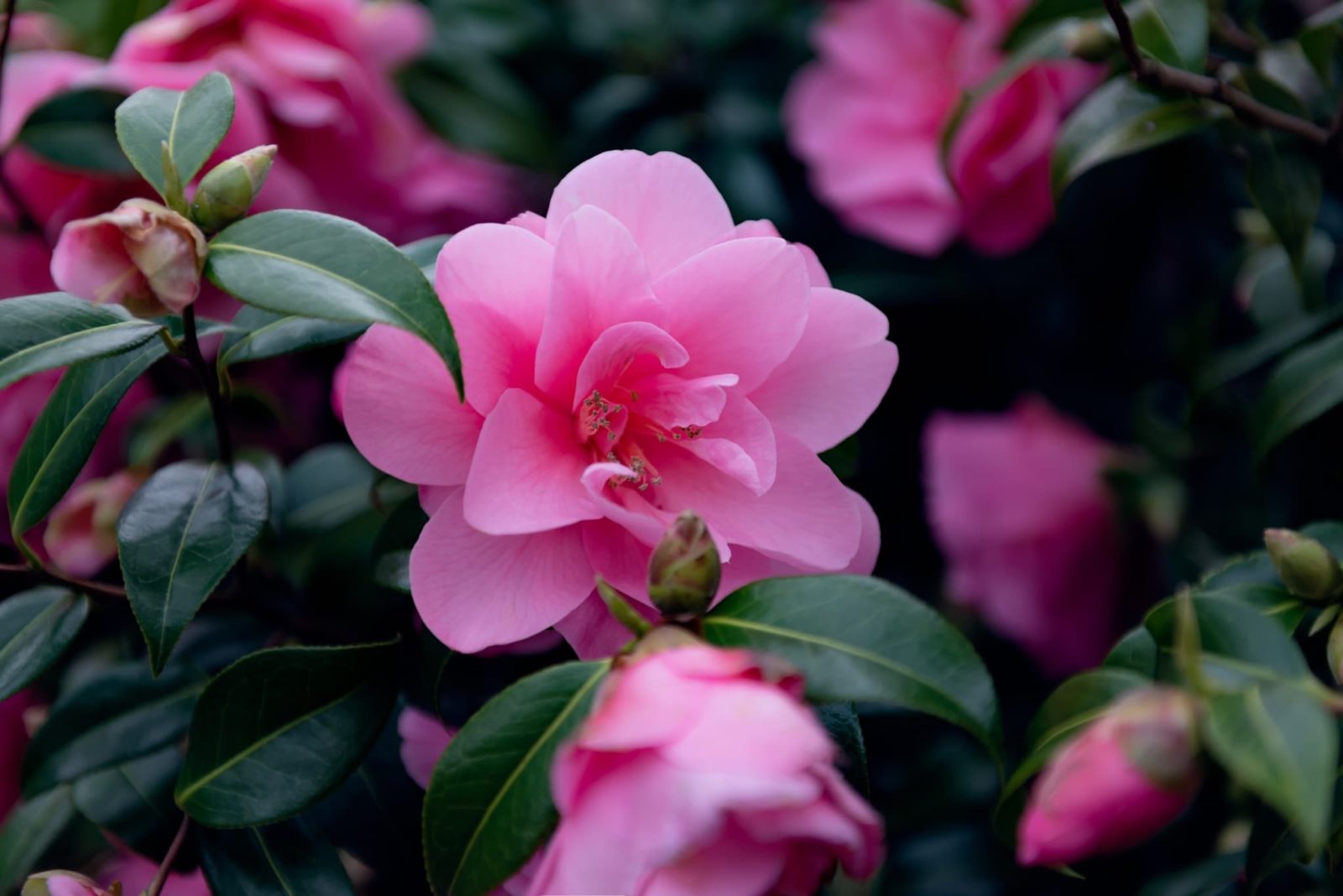
Reviewed By COLIN SKELLY

Colin is a Horticulturist and Horticultural Consultant with experience in a range of practical and managerial roles across heritage, commercial and public horticulture. He holds the Royal Horticultural Society’s Master of Horticulture award and has a particular interest in horticultural ecology and naturalistic planting for habitat and climate resilience.
Contributions From PATRICIA SHORT

Patricia has over 35 years of experience growing camellias in her garden and is passionate about the joy they can bring to the dull winter months.

Lorraine has worked with camellia plants for over 40 years. Based in Wimborne (Dorset), the nursery has various camellia species, cultivars and hybrids for sale and has links to the International Camellia Society.
IN THIS GUIDE
- 1) C. japonica
- 2) C. sasanqua
- 3) C. chrysantha
- 4) C. japonica ‘Akashigata’
- 5) C. sasanqua ‘Plantation Pink’
- 6) C. sasanqua ‘Winter’s Snowman’
- 7) C. x williamsii ‘E.G. Debbie’
- 8) C. sasanqua ‘Apple Blossom’
- 9) C. japonica ‘Nuccio’s Gem’
- 10) C. japonica ‘Magnoliaeflora’
- 11) C. japonica ‘Margaret Davis’
- 12) C. japonica ‘Eleanor Martin Supreme’
- 13) C. japonica ‘Higo Okan’
- 14) C. japonica ‘Masayoshi’
- 15) C. saluenensis
- 16) C. sinensis
- 17) C. reticulata
- References
Though Camellias are native to a limited range in the tropical and sub-tropical regions of East Asia and South-East Asia, they have been hybridised in Europe and the United States.1Camellia japonica. (n.d.-c). Missouri Botanical Garden. Retrieved March 13, 2023, from https://www.missouribotanicalgarden.org/PlantFinder/PlantFinderDetails.aspx?taxonid=287331
A century ago Camellia flowers used to be just about the most fashionable in Europe.
As popular as Camellia plants still are in many a European country, they are even more popular in the American South and California.2Bender, S. (2022, November 13). The Complete Guide To Camellias. Southern Living. Retrieved March 13, 2023, from https://www.southernliving.com/garden/camellias
As a result of their popularity, there are 230 Camellia species, whilst hybrids and cultivars number over 20,000!3Camellia. (n.d.). Kew Royal Botanic Gardens. Retrieved May 2, 2023, from https://powo.science.kew.org/taxon/urn:lsid:ipni.org:names:39017-1#children
“When asked which is his favourite camellia, my husband always answers: ‘the one I saw last’,” says Patricia Short from the International Camellia Society.
“My favourite variety? I couldn’t possibly choose.
“I love the different flower forms of camellias, from single purity to formal elegance. Also, some cultivars have a scent, which is a true delight”.
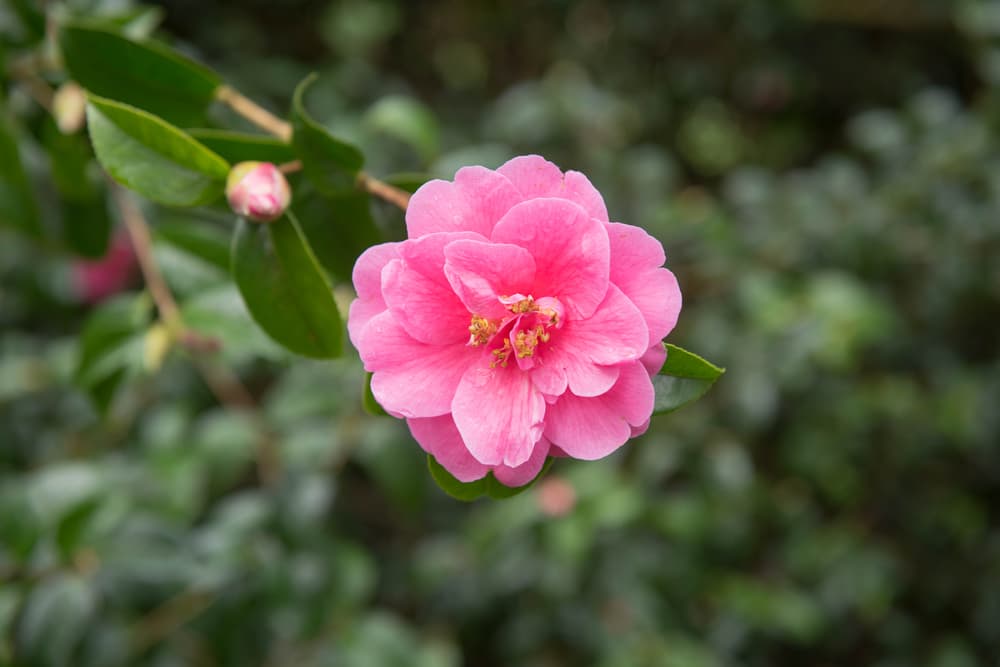
“I have Camellia ‘Inspiration’ in my own garden as it flowers from January to April and is always covered in flowers every year,” shares Lorraine Summers from Trehane Nursery.
“Betty Foy Sanders is striped and that’s lovely as well. San Dimas is a lovely dark red with yellow stamens.
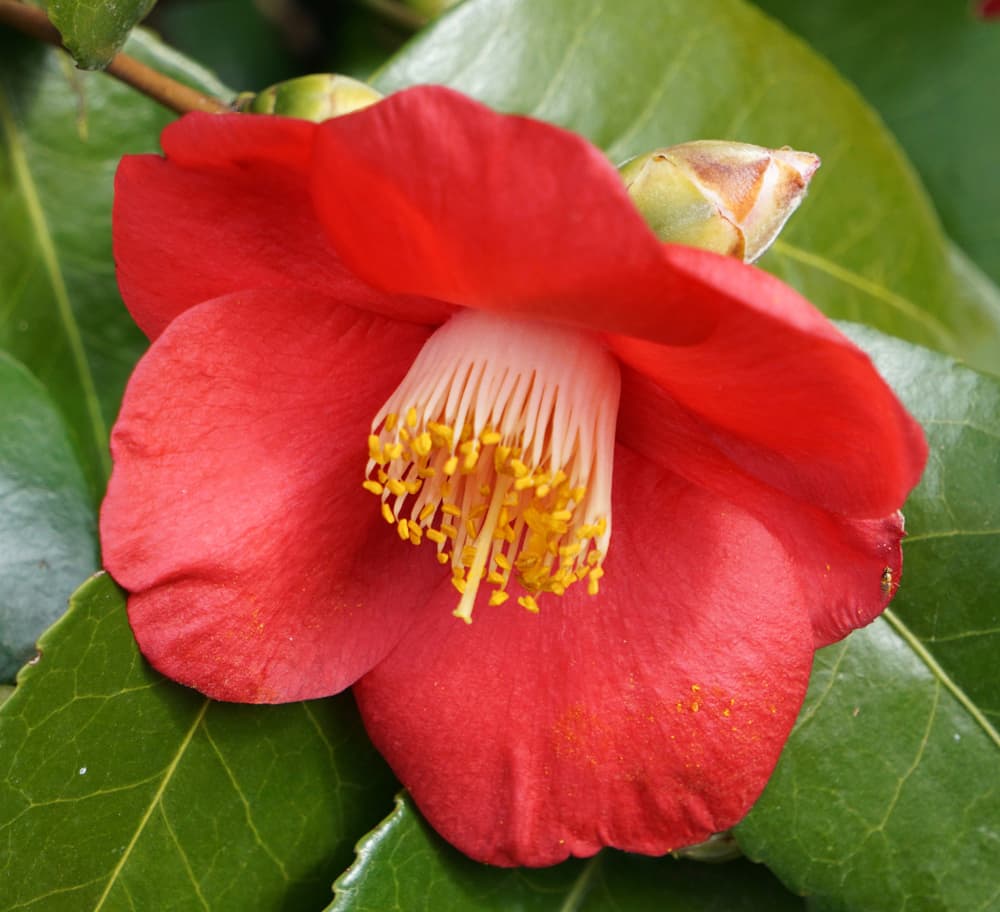
“There are too many to choose from!”
The most famous species, and the ones from which most hybrids and cultivars descend, are C. japonica and C. sasanqua.
Underneath we review these two species plus more varieties chosen for their marvellous blooms.
1) C. japonica
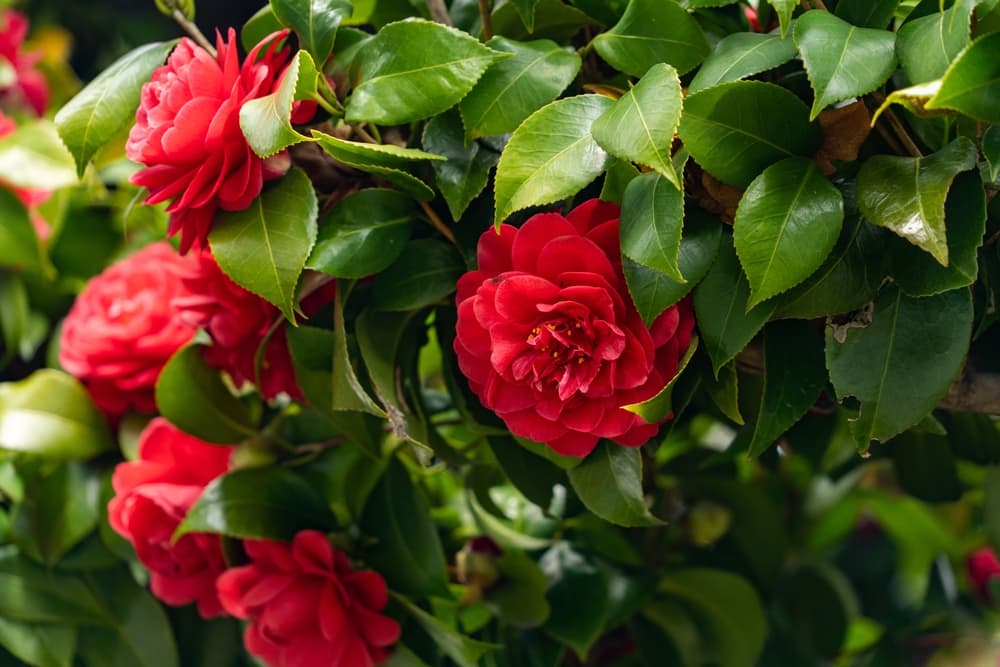
Native to Southern China, Japan, and the Koreas, growing in nature on wooded hillsides.4Camellia japonica. (n.d.-d). Kew Royal Botanic Gardens. Retrieved March 13, 2023, from https://powo.science.kew.org/taxon/urn:lsid:ipni.org:names:828524-1
Its typical height is 5-6m though it can attain much taller heights.
The distinctly leathery, glossy leaves are dark green.
The showy flowers have a relatively robust look about them; they comprise of six or seven petals and are white or in tones of rose-red.
They are 5-9cm in diameter, while some cultivars’ flowers are up to 12 centimetres across.
It blooms from the middle of winter to the end of Spring. It is not a profuse bloomer but flowers are relatively long-lasting.
2) C. sasanqua
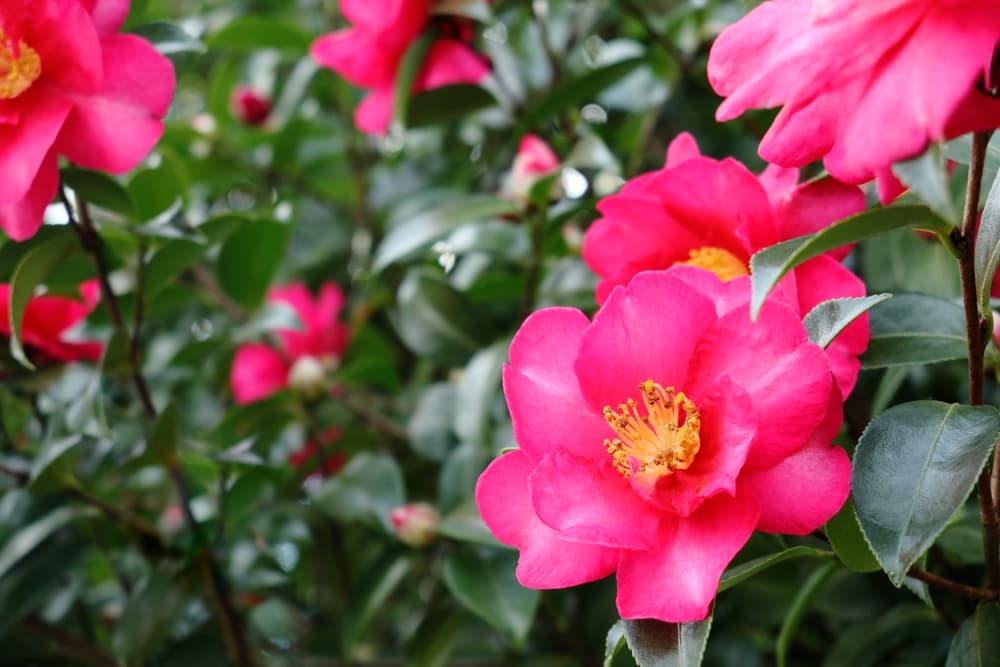
Native to Japan, it too is found in nature on wooded hillsides.5Camellia sasanqua. (n.d.). Kew Royal Botanic Gardens. Retrieved March 13, 2023, from https://powo.science.kew.org/taxon/urn:lsid:ipni.org:names:927409-1
Its typical height is up to 4m and seldom gets very tall.
The serrated leaves are glossy and of a deep-green hue.
The flowers, though showy, are less so than those of C. japonica.
They have a more delicate look, and the five to eight petals are usually ruffled or fluted.
Flowers are 5-7cm in diameter, while some cultivars’ flowers are up to 10cm across.
Blooming time is early Autumn to mid-Winter – they are very profuse bloomers but a flower lasts only two or three days.
Clearly, C. japonica and C. sasanqua are nature-made complements of one another.
Because sub-species and cultivars in the main inherit the parent species’ characteristics, these two species’ derivatives complement each other wonderfully well.
3) C. chrysantha
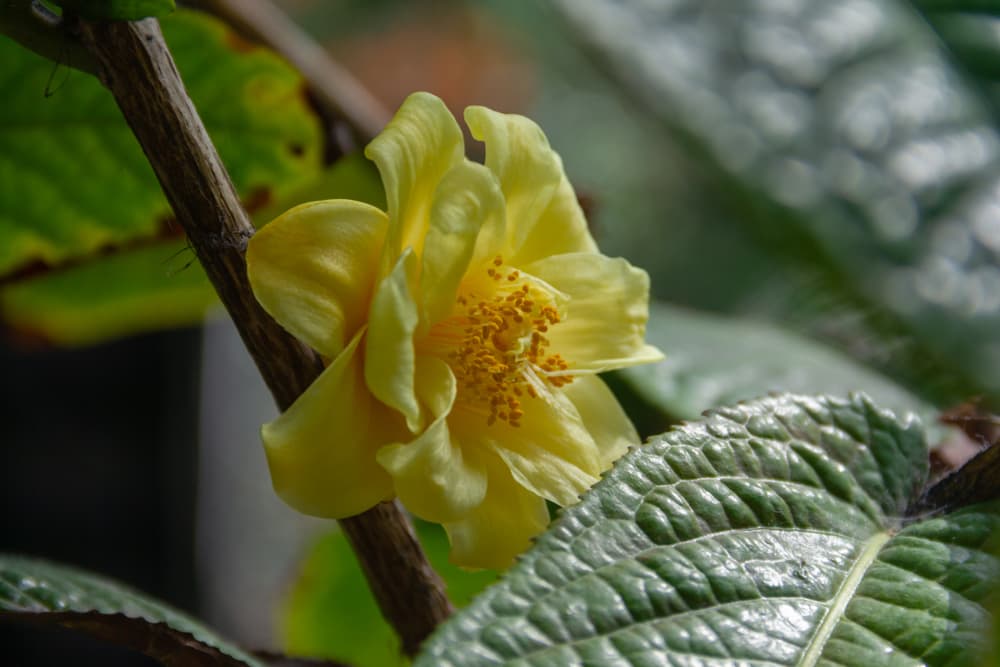
This is not a cultivar but a distinct species that is native to China and Vietnam.
Unlike the other Camellias listed below, this one’s as common as hen’s teeth.
“Camellia chrysantha is now on my watch list as I’ve never seen it in cultivation before,” shares Colin Skelly, a Horticultural Consultant with over 13 years of experience.
“Whilst I like the tried and tested, there’s nothing like trying something rarer and more unusual and watching people try to identify your prize specimen!”
If you can find a plant it will extend your garden’s Camellia blooming season clear into April.
On top of that, the semi-double flower will introduce possibly the rarest colour for a Camellia to your collection: yellow!
4) C. japonica ‘Akashigata’
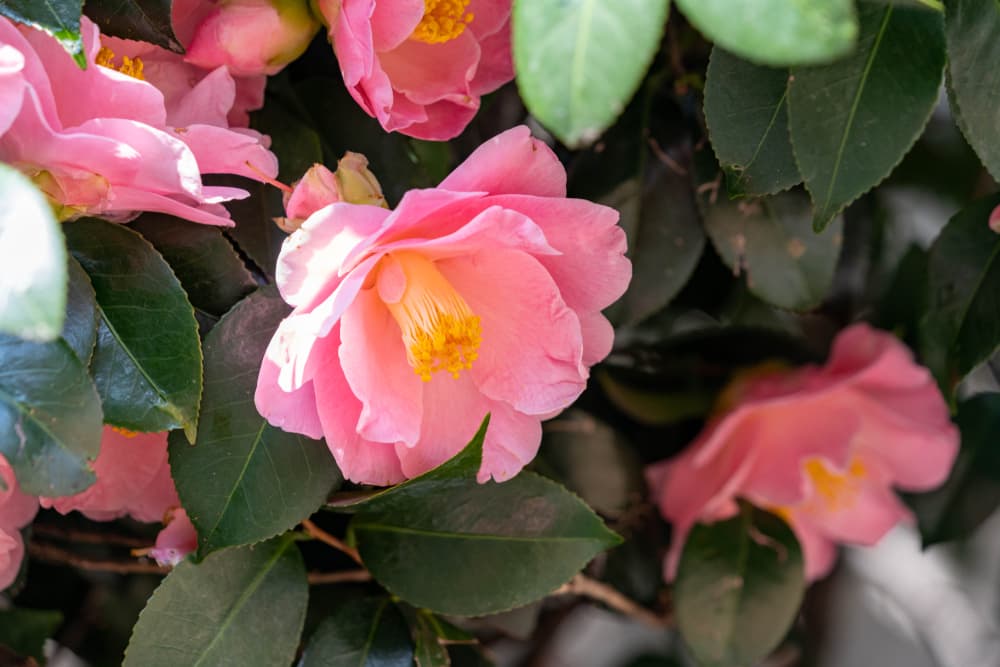
A medium-sized shrub though its flowers are anything but.
Up to 12cm in diameter, they are among the largest but that is not this plant’s only attraction.
The semi-double form flower has a somewhat delicate appearance and is gorgeously coloured; it ranges from pastel pink to deep, rich rose-pink.
5) C. sasanqua ‘Plantation Pink’

Of upright habit and robust appearance, this plant bears single to semi-double flowers whose fragile appearance contrasts with that of the plant.
The stamens form a central yellow disk which sets off the soft pink petals.
Quite often they are not exactly pink but a tone of bluish-pink that is unusual and highly appealing.
6) C. sasanqua ‘Winter’s Snowman’
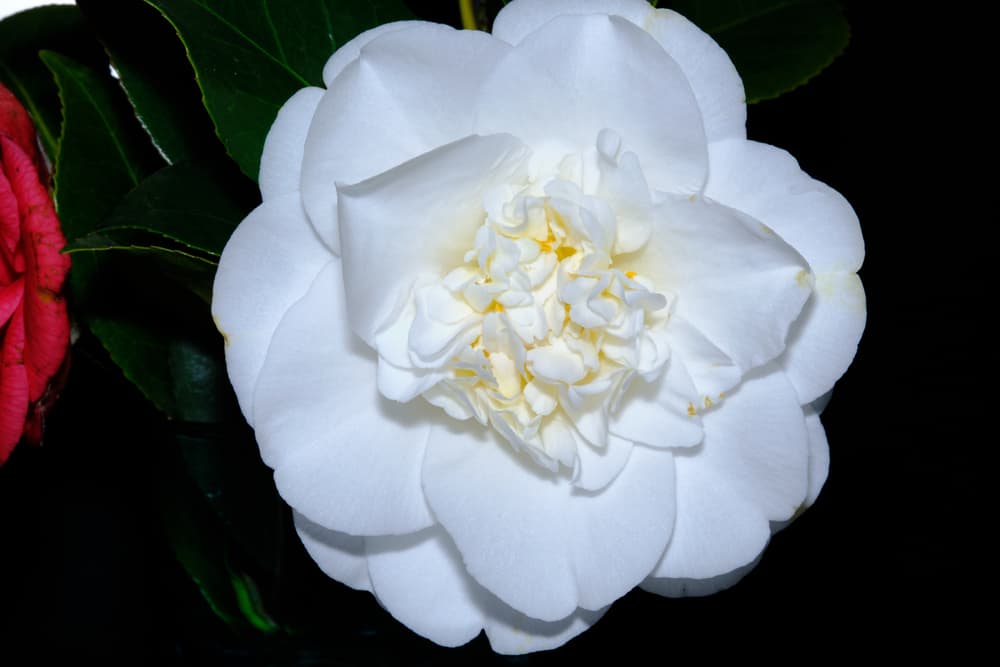
The plant is large, the flower fragrant, and the stamens distinctly fewer and less prominent than in most varieties, and often hidden by a folded or ruffled petal.
This clever concealment leaves the pure, snowy white of the semi-double flowers to make an even greater visual impact.
7) C. x williamsii ‘E.G. Debbie’
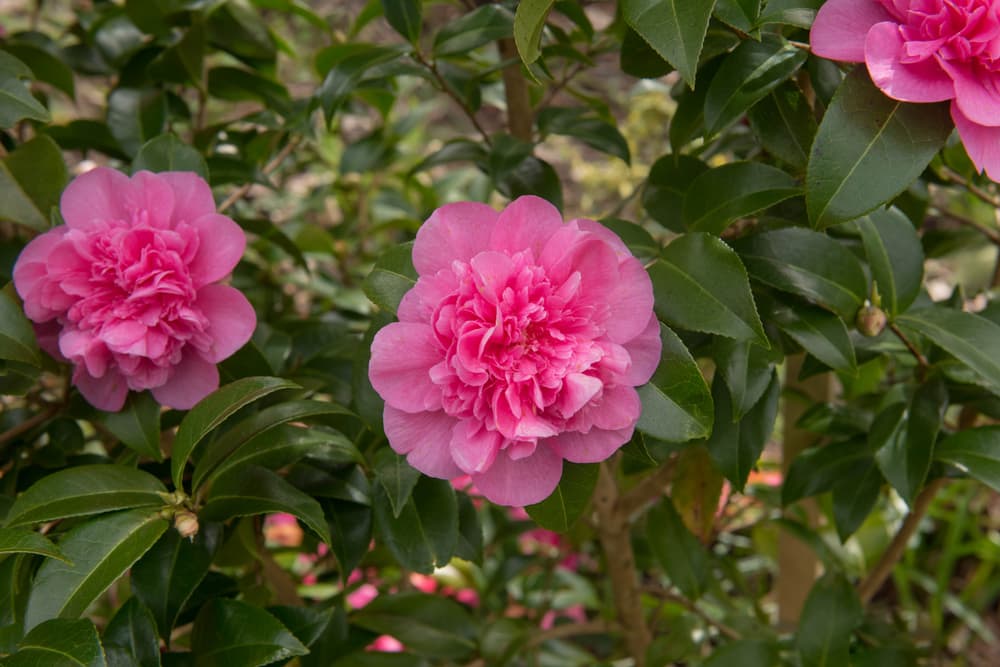
Could just as well be named ‘Pink Perfection’.
Carrying a hue that is the very definition of pink and boasting perfect symmetry in its somewhat prim-looking formal double flower, it projects both softness and grace.
The upright and neat habit of the plant only adds to the overall perfection.
8) C. sasanqua ‘Apple Blossom’
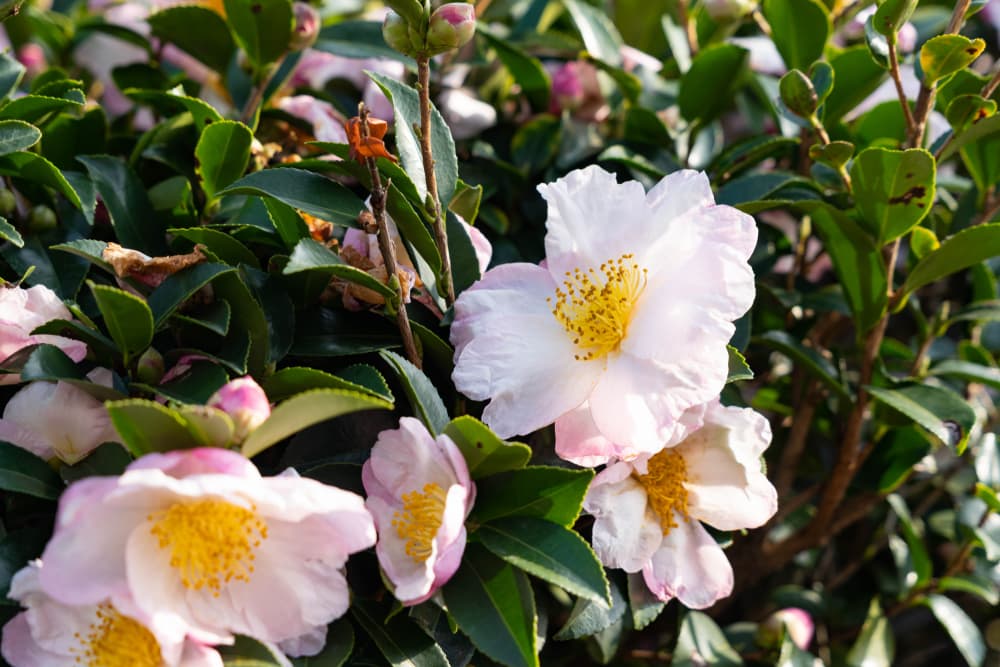
One of the under-rated Camellia varieties.
There is also a C. japonica ‘Apple Blossom’.
Against a backdrop of darker-than-usual glossy leaves, the semi-double bloom looks absolutely ravishing.
It is of a gradated tone, starting snowy white near the centre, developing pink tinges and tints, and finishing with rose pink at the edges.
9) C. japonica ‘Nuccio’s Gem’
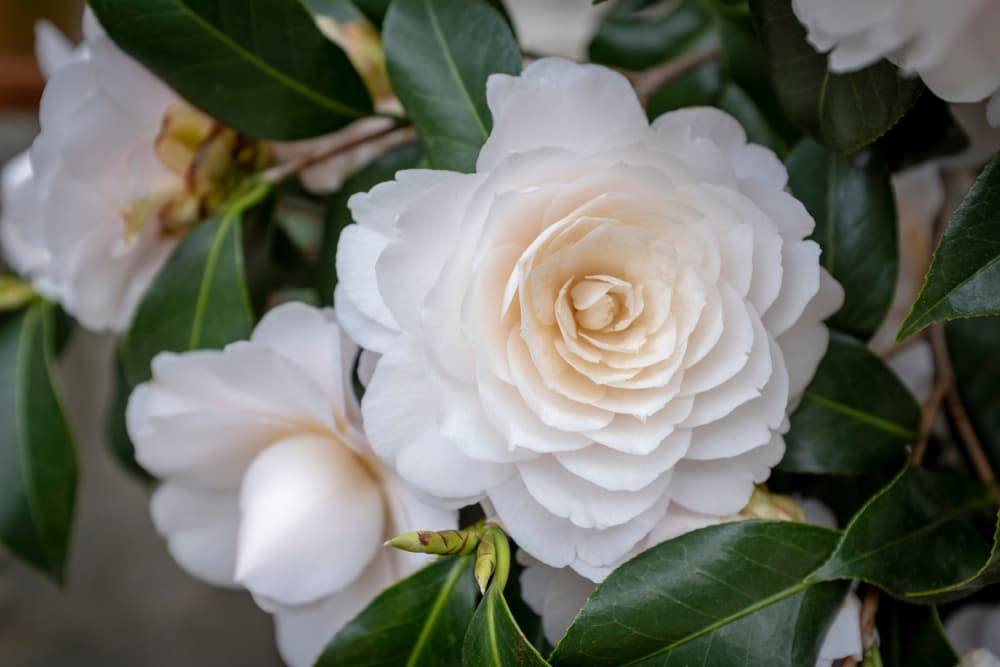
Causes the word ‘perfection’ to come to mind again, or the word ‘stunning’.
One scarcely pays heed to the shrub’s height or habit because this formal double is a pure, snowy white from centre to edge.
Even an imperfect specimen may deceive you into thinking that you are admiring a flower sculpted from Parian marble.
10) C. japonica ‘Magnoliaeflora’
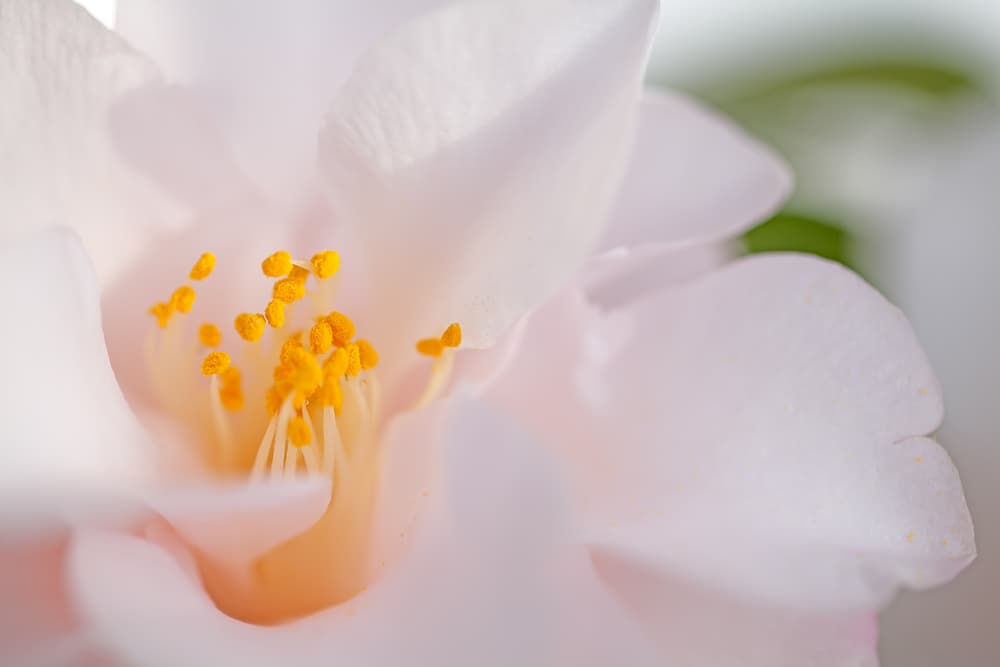
A cultivar dating from well over a century ago; it is of medium height and spreading habit.
The semi-double flowers are among the loveliest; to begin with they present an unusually symmetrical aspect.
However, their unique loveliness derives from their very pale pink-purple-blue tones.
11) C. japonica ‘Margaret Davis’

Of upright habit with glossy bronze-green foliage behind a dazzler of a flower.
In peony form, it is creamy white with rose-red edging as if stroked with a fine brush, and the red ‘bleed’ into the white makes the bloom even more arresting.
This edging is present on all the petals and not just the outer ones.
12) C. japonica ‘Eleanor Martin Supreme’
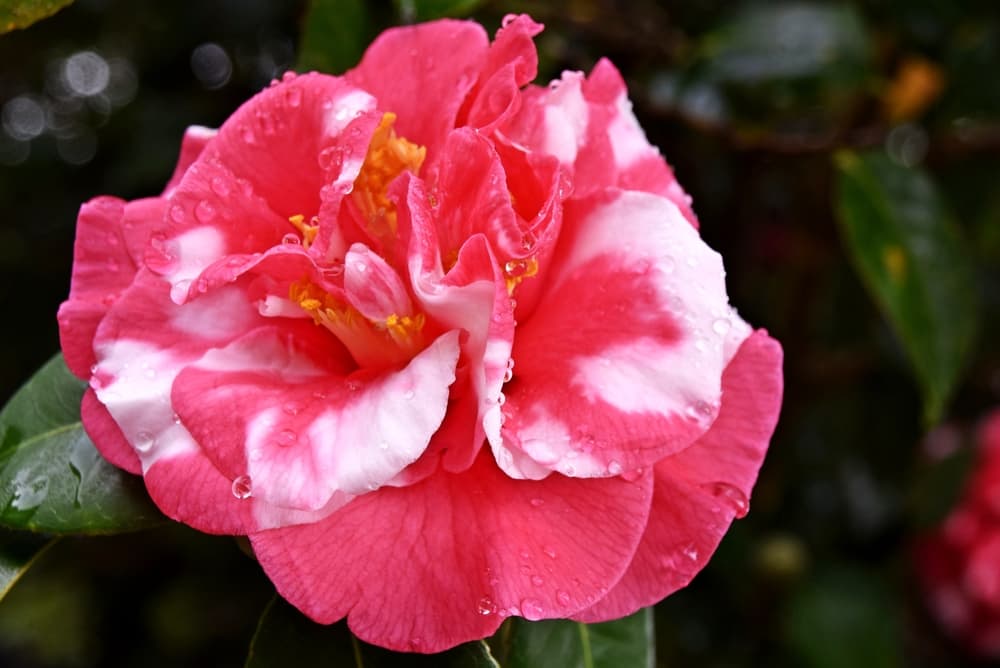
An exhibit – for those who say that the Camellia flower presents a ‘sculpted’ aspect, Eleanor Martin Supreme shows off the ‘marbling’.
This unusual and beautiful American cultivar bears large semi-double bicoloured flowers that display white ‘marbling’ (or dappling) on a rose-pink background – or is it the other way round?
13) C. japonica ‘Higo Okan’
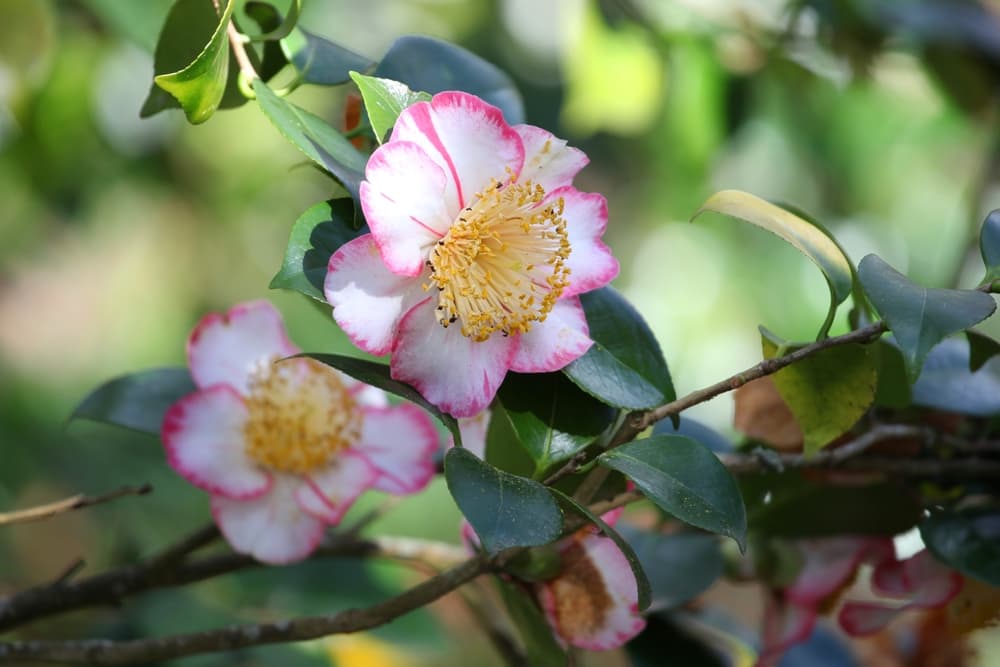
Now if marbled flowers are not your cup of tea but bi-coloured flowers are, try this evergreen shrub, the Camellia of the Samurai.
As the stamens are even more numerous and prominent than usual, this single-form flower effectively has a central disk in yellow, snow white petals, and an edging or bordering of varying thickness in shades of hard pink to scarlet.
14) C. japonica ‘Masayoshi’
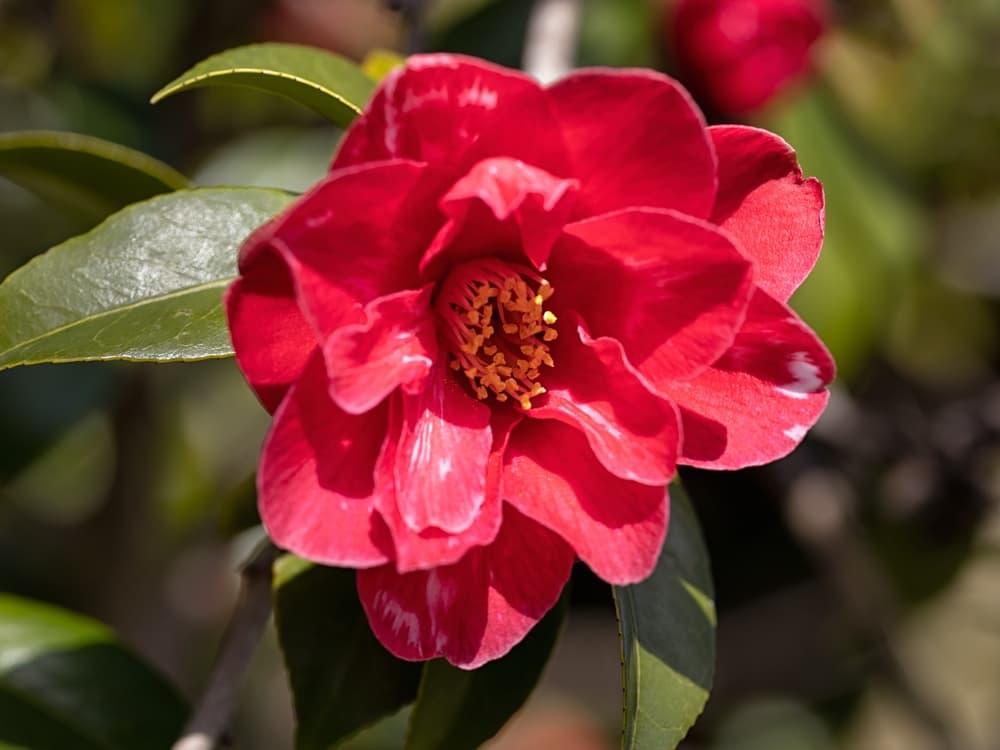
Another bi-coloured variety but of an entirely different kind.
The plant is smallish and compact, and yet again the flowers are at the other extreme, being 12cm wide.
Of semi-double form, the flowers display delightful bleeds, flecks, stripings, dapples, and splashes of white on a red background.
Other important species include:
15) C. saluenensis
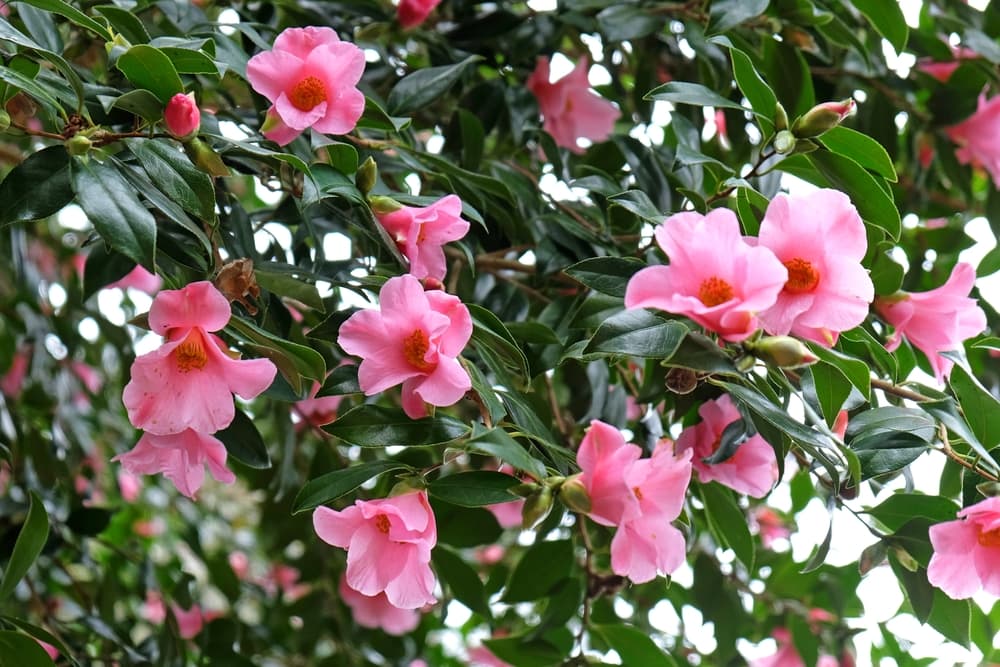
16) C. sinensis
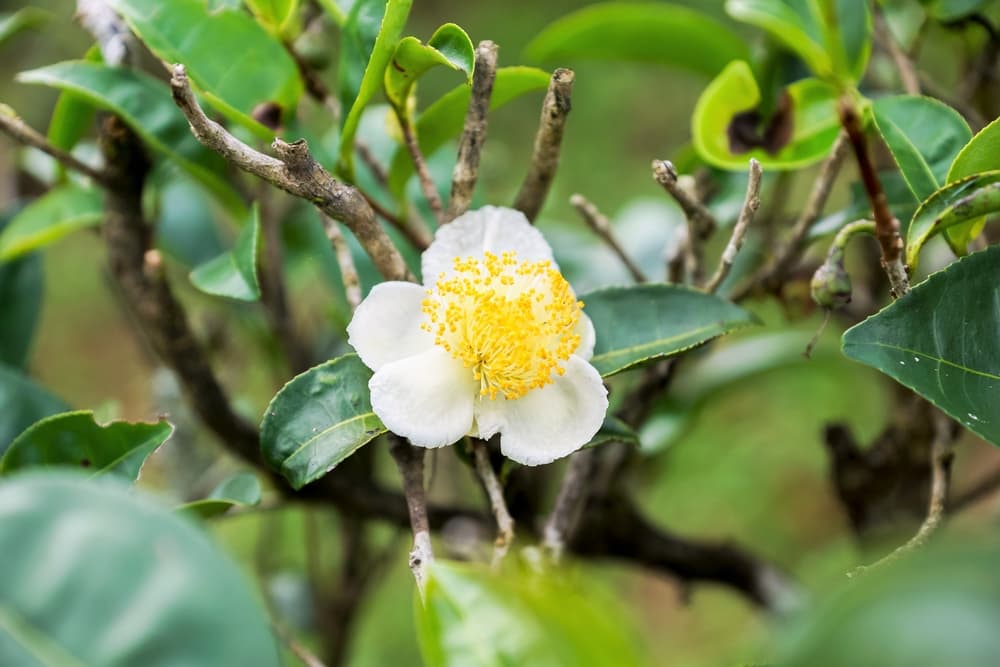
17) C. reticulata
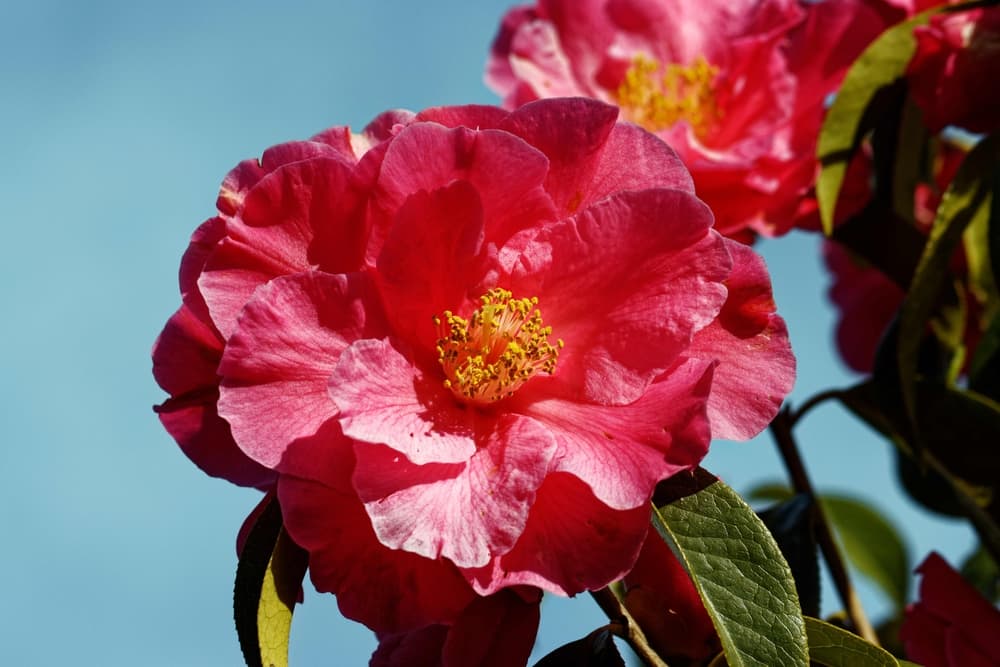
References
- 1Camellia japonica. (n.d.-c). Missouri Botanical Garden. Retrieved March 13, 2023, from https://www.missouribotanicalgarden.org/PlantFinder/PlantFinderDetails.aspx?taxonid=287331
- 2Bender, S. (2022, November 13). The Complete Guide To Camellias. Southern Living. Retrieved March 13, 2023, from https://www.southernliving.com/garden/camellias
- 3Camellia. (n.d.). Kew Royal Botanic Gardens. Retrieved May 2, 2023, from https://powo.science.kew.org/taxon/urn:lsid:ipni.org:names:39017-1#children
- 4Camellia japonica. (n.d.-d). Kew Royal Botanic Gardens. Retrieved March 13, 2023, from https://powo.science.kew.org/taxon/urn:lsid:ipni.org:names:828524-1
- 5Camellia sasanqua. (n.d.). Kew Royal Botanic Gardens. Retrieved March 13, 2023, from https://powo.science.kew.org/taxon/urn:lsid:ipni.org:names:927409-1

